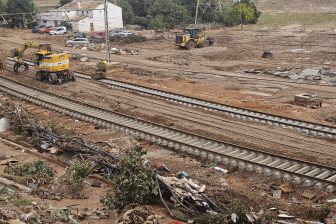
Candidates line up as EU searches Ukrainian grain export solutions
Several countries attempt to get into the game of exporting Ukrainian grain after Russia withdrew from the Grain Deal. Lithuanian Ministers sent a joint letter to the EU Commission requesting assistance in establishing a rail export corridor via the Baltic countries. At the same time, Bulgarian and Greek Prime Ministers discussed the possibility of Bulgarian Railways transporting Ukrainian grain to from Romania to the Greek port of Alexandroupolis.
After Russia withdrew from the UN-brokered Grain Deal, the already fragile endeavour of exporting Ukrainian agricultural products was at stake again. In a conversation with RailFreight.com a few days ago, Andrii Dykun, chairman of the Ukrainian Agri Council, explained that the immediate solutions that would be implemented would entail grain exports via the Moldovan railways and barge services connecting to Danube ports.
The Polish question
Dykun also mentioned that rail services between Ukraine and Poland could come to the rescue in September, as currently, the border for rail services is closed. The situation between Poland and Ukraine is quite unclear, with Polish officials asking the EU to extend the ban on Ukrainian grain imports after 15 September. A few days ago, the Polish Prime Minister stated that the Polish border would not open to Ukrainian products if the ban did not get an extension.
Ukraine accused Poland of following an unfriendly and populist policy. In response, the Polish Prime Minister said that this was a misconception and that Poland and the rest of the EU countries that imposed an import ban on Ukrainian grain would still allow it to transit to other destinations. In any case, until the situation clears, more candidates seem willing to help. What are the possibilities of the proposed solutions, and how easily could they go into practice?
The Baltic Way
Lithuanian governmental officials like the Minister of Foreign Affairs of Lithuania, Gabrielius Landsbergis, the Minister of Transport, Marius Skuodis and the Minister of Agriculture, Kęstučius Navickas, wrote a joint letter to EU Commission officers. The letter asked them to back the possibility of using rail services towards Baltic ports to export Ukrainian grain. They came up with the ‘Baltic Way’ concept, which is nothing else than the Ukraine-Baltics transport route via Lithuania.
The Ministers said the Baltic route could become “a promising and long-term alternative” given the needed improvements. The improvements should include the upgrade of rail infrastructure and transhipment facilities and simplified administrative procedures at the Polish-Ukrainian border by “introducing green lines and transferring customs procedures to the ports of the Baltic countries.”
Realistically speaking, improving infrastructure and facilities in such a short period could be difficult. However, the possibility of a favourable regime that would facilitate services on an administrative level could be more feasible and, indeed, boost volumes through this corridor. In this case, a prerequisite is stabilising the situation between Poland and Ukraine to enable a more favourable export regime.
The cargo subsidiaries of Lithuanian Railways, LTG Cargo Polska and LTG Cargo Ukraine could help significantly with this task since they already carry out services in Poland, Ukraine and the Baltics and have the needed technical knowledge to work with a gauge difference.
The Bulgaria-Greece corridor
Another interesting proposal came from the meeting of the Prime Ministers of Bulgaria and Greece. Nikolay Denkov and Kyriakos Mitsotakis discussed the possibility of using Bulgarian rail to collect grain volumes from the Romania-Bulgaria border and transport them all the way to the Northern Greek port of Alexandroupolis. From Alexandroupolis, grain could tranship on ships and continue to other markets.
The two countries have been cooperating closely on a transport level. In fact, they are working on establishing a rail transport corridor between them that will run from the port of Alexandroupolis to Ruse, a Danube riverport on the Bulgarian-Romanian border. The corridor will also cross through the Bulgarian port hubs of Burgas and Varna.
According to official sources, the Bulgarian government also plans to invest in the port of Alexandroupolis to develop it into an Eastern Mediterranean hub that can level up transportation in the region with its intermodal profile. The Greek port already has rail connections, facilities and rail freight technical know-how that have been highlighted via military mobility since NATO troops use it as their base. The port is also set to acquire a new rail connection towards Bulgaria before the end of this decade.
Setting up a grain export supply chain via Bulgaria and Greece could be a good crash test for the plans that the two countries share. However, such a task needs immediate solutions and actions that cannot rely on future ideas. The shared railway route between the two countries still needs significant improvements to facilitate more traffic, while a pressing question is whether Bulgarian Railways have the required capacity and equipment to allocate for this mission. The answer is probably no, at least for now; however, this could prove a valuable solution in the future and develop into a new corridor for rail business.



